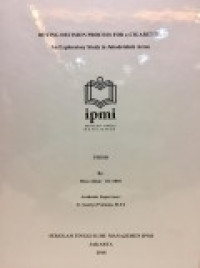
The Influence of Solvency and Liquidity to Sustainability on the Coal Mining Industry in the year 2012-2016: Analysis of the listed companies in Indonesia 2018
| Gmd : Text
| Availability :
| 2018CS127 | CS/127 | (THESIS S1) | Available |
Since the year 1990s, coal-mining industry in Indonesia has been reopened for their overseas investment. This industry runs well until in 2008 there has been a global financial crisis, which led to the fluctuation of coal prices. Indonesia’s coal reserve is ranked 9th with the total 2.2% of the total global reserves, but it is estimated to be depleted approximately in the next 83 years if current production levels are continued. With this situation, it is important for the company to concern about the sustainability issues. Sustainability (3Ps) has been one of the most important aspects that every corporation needs to pay attention. In doing the sustainability activities, a corporation needs to allocate some cost. This study would like to analyze whether the company is able to do sustainability activities. The financial ratios that we would like to use are the liquidity and solvency ratio. It is predicted that the liquidity and solvency ratio impact the company’s ability to do sustainability since it measures the company’s short-term and long-term performances. Liquidity ratio is the company’s ability to manage its short-term debt obligations, which consists of current ratio, quick ratio, and cash ratio. Solvency ratio is used to measure a company’s ability to manage both the short-term and long-term obligations. It includes debt-to-assets ratio, debt-to-equity ratio and times interest earned. The sustainability is measured with the GRI G4 Specific Standard Disclosure, which consists of the economy, environmental, labor practices and decent work, human rights, society, and product responsibility. The data was taken from the 17 coal mining industries listed in Indonesia Stock Exchange in the year 2018, which has the annual report in the year 2012-2016. The classical assumption tests will be done to make sure the model can be used for the study. Then, the hypotheses tests will be taken to get the answer to the problem statements. The conclusion from the two problem statements that are being observed in this study is that the solvency ratio is significantly affecting the company’s sustainability while the liquidity ratio does not.
| Series Title |
-
|
|---|---|
| Call Number |
CS/127
|
| Publisher Place | Jakarta |
| Collation |
viii, 107p; 30cm
|
| Language |
English
|
| ISBN/ISSN |
-
|
| Classification |
NONE
|
| Media Type |
-
|
|---|---|
| Carrier Type |
-
|
| Edition |
-
|
| Subject(s) | |
| Specific Info |
-
|
| Statement |
-
|
| Content Type |
-
|
No other version available







